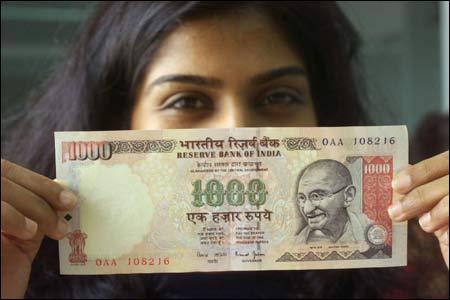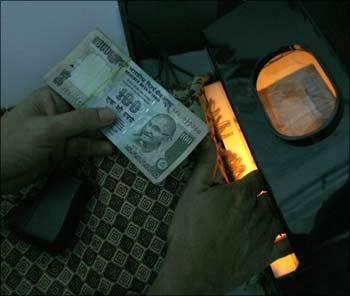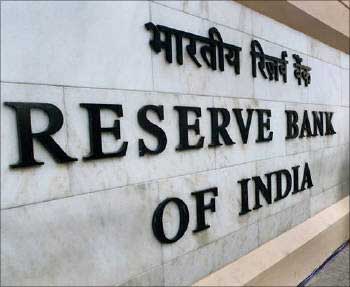
The distribution of currency notes of various denominations in India appears to be heavily skewed in favour of the rich.
The section on currency management in the Annual Report of the Reserve Bank of India shows that at the end of March 2010, 12.9 per cent and 4.2 per cent of the total volume of notes in circulation with denominations of Rs 500 and Rs 1,000 accounted for 46.2 per cent and 30.2 per cent of the total values. These proportions display a rising trend.
The skew is only a reflection of the highly unequal distribution of income, wealth and economic transactions. But currency management should be centred on the common man.
The vast majority of people deal in transactions of relatively small values at one time and have no need for high-value denominations. Automated teller machines (ATMs) discharge high-value notes, making it necessary for many to visit the bank counters again to get change in smaller denominations.
It discourages customers who want to withdraw small amounts from using the machines. The data show that the Rs 10 notes showed the highest growth rate both in terms of the volume and value.
. . .

Small-value transactions at the counter increase the cost of banking service. If there is a problem in accommodating a large number of notes in the slots of the machines, it can be solved by prescribing a maximum withdrawal of, say, Rs 5,000 at one time.
Anyone who wants to draw a higher amount could do so in more than one instalment in one visit. In fact, this system prevailed in the past and it was successful in dispensing notes of the denominations of Rs 100 and Rs 10.
Incidentally, many banks have reported that a substantial proportion of customer transactions is carried out off-site using the ATMs and the Internet.
If that were the case, should it not result in a reduction in bank service charges? There is no rationale for a bank to charge Rs 100 per consolidated statement of the transactions in a year.
In the West, high-value notes were given up long ago partly due to their misuse in illegal activities and partly due to the extensive use of the banking system to carry out transactions through electronic devices.
. . .

As far as the Indian rich are concerned, they have access to modern means of payment that do not require cash. So, the only remaining purpose that is served by high-value notes is to provide a means to facilitate illegal activities by anti-social elements.
This writer conducted an enquiry with the department concerned when he was in RBI's service. He found that there was no scientific way of determining the demand for notes of various denominations. It was decided on an ad hoc basis using some rule-of-thumb growth rates.
It is quite likely that the situation continues to be so and the distribution of notes is still supply-determined.
A few decades ago, the RBI asked the Indian Statistical Institute, (then) Calcutta, to undertake a project determining a methodology for estimating the demand for notes of different denominations.
. . .

The report was not published. A recent enquiry with the RBI by this writer under the Right to Information Act revealed that the report was not traceable! In any case, the RBI needs to change its priorities in relation to the denomination of notes.
The report refers to the RBI taking steps to conduct a field trial of plastic notes in the denomination of Rs 10 in 2010-11 to gather lessons in order to raise their longevity. Although there are other countries with plastic notes, I know of one instance when it was tried and given up due to certain practical difficulties.
During my visit to the Bank of Thailand a few years ago, I was told that plastic notes were no longer in use for two reasons. One, the staff working in the printing press objected to the obnoxious fumes and smells of the plastic being processed. Two, the common man experienced difficulties in folding the notes in his wallet.
The RBI would do well to contact a few countries that are using plastic notes to learn about their initial problems and how they surmounted them.
. . .

As regards small coins below the value of Rs 1, 52 per cent of the total volume accounted for 13 per cent of the value at the end of March 2010. Prices are getting rounded off to the nearest rupee and even when the value of a transaction requires a fraction of a rupee, the vendor advises the buyers to buy the required additional quantity to avoid it.
There used to be periodical shortages and surpluses of coins in the past that reminded one of the Cobweb cycle. The RBI is right in not having placed any indent for coins below the value of 50 paise.
The RBI and the government mint should stop the practice of frequently changing the design of coins. At present, it is often difficult to distinguish between Rs 1 and the new Rs 2 coins.
Coins in the US, viz. dime, nickel, quarter and half dollar, have not changed in shape and size for many years. Considering the use of coins in automated machines, like those used for weighing oneself, and the requirements of the blind, it is desirable that the designs should be unchanged.
The author is an economic consultant (Former officer-in-charge, Department of Economic Analysis and Policy, Reserve Bank of India, and IMF Adviser to National Bank of Kyrgyzstan and Bank of Sierra Leone).